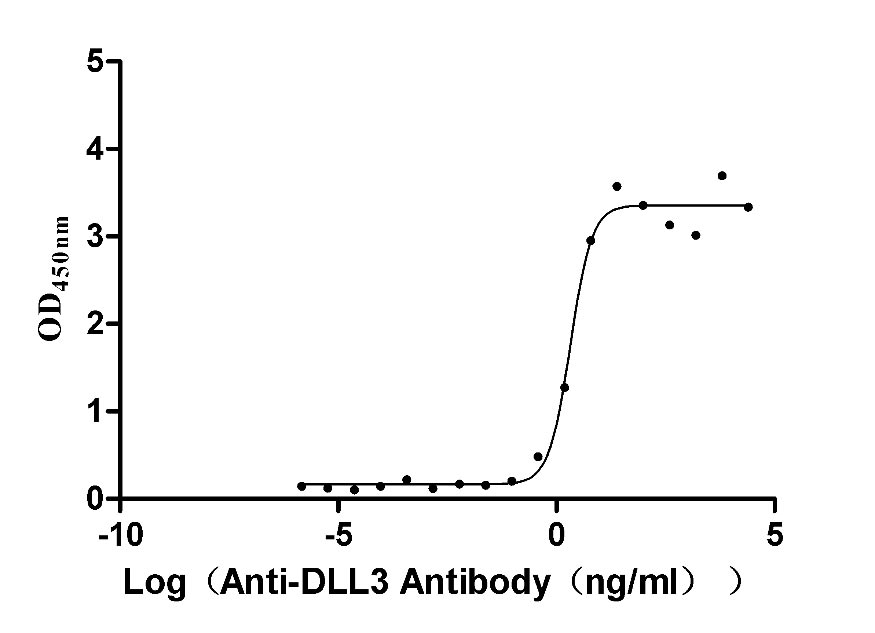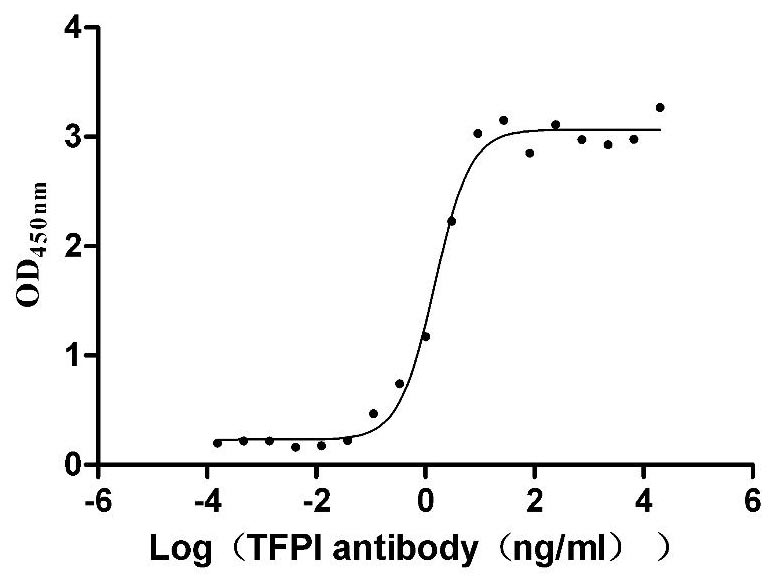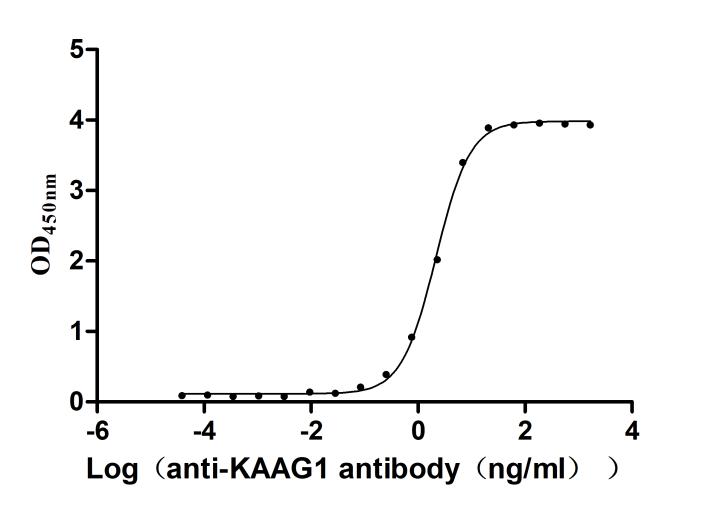Recombinant Mouse C-X-C chemokine receptor type 4 (Cxcr4), partial
-
货号:CSB-YP006254MO1
-
规格:
-
来源:Yeast
-
其他:
-
货号:CSB-EP006254MO1
-
规格:
-
来源:E.coli
-
其他:
-
货号:CSB-EP006254MO1-B
-
规格:
-
来源:E.coli
-
共轭:Avi-tag Biotinylated
E. coli biotin ligase (BirA) is highly specific in covalently attaching biotin to the 15 amino acid AviTag peptide. This recombinant protein was biotinylated in vivo by AviTag-BirA technology, which method is BriA catalyzes amide linkage between the biotin and the specific lysine of the AviTag.
-
其他:
-
货号:CSB-BP006254MO1
-
规格:
-
来源:Baculovirus
-
其他:
-
货号:CSB-MP006254MO1
-
规格:
-
来源:Mammalian cell
-
其他:
产品详情
-
纯度:>85% (SDS-PAGE)
-
基因名:
-
Uniprot No.:
-
别名:Cxcr4; Cmkar4; Lestr; Sdf1r; C-X-C chemokine receptor type 4; CXC-R4; CXCR-4; Fusin; Leukocyte-derived seven transmembrane domain receptor; LESTR; Pre-B-cell-derived chemokine receptor; PB-CKR; Stromal cell-derived factor 1 receptor; SDF-1 receptor; CD antigen CD184
-
种属:Mus musculus (Mouse)
-
蛋白长度:Partial
-
蛋白标签:Tag type will be determined during the manufacturing process.
The tag type will be determined during production process. If you have specified tag type, please tell us and we will develop the specified tag preferentially. -
产品提供形式:Lyophilized powder
Note: We will preferentially ship the format that we have in stock, however, if you have any special requirement for the format, please remark your requirement when placing the order, we will prepare according to your demand. -
复溶:We recommend that this vial be briefly centrifuged prior to opening to bring the contents to the bottom. Please reconstitute protein in deionized sterile water to a concentration of 0.1-1.0 mg/mL.We recommend to add 5-50% of glycerol (final concentration) and aliquot for long-term storage at -20℃/-80℃. Our default final concentration of glycerol is 50%. Customers could use it as reference.
-
储存条件:Store at -20°C/-80°C upon receipt, aliquoting is necessary for mutiple use. Avoid repeated freeze-thaw cycles.
-
保质期:The shelf life is related to many factors, storage state, buffer ingredients, storage temperature and the stability of the protein itself.
Generally, the shelf life of liquid form is 6 months at -20°C/-80°C. The shelf life of lyophilized form is 12 months at -20°C/-80°C. -
货期:Delivery time may differ from different purchasing way or location, please kindly consult your local distributors for specific delivery time.Note: All of our proteins are default shipped with normal blue ice packs, if you request to ship with dry ice, please communicate with us in advance and extra fees will be charged.
-
注意事项:Repeated freezing and thawing is not recommended. Store working aliquots at 4°C for up to one week.
-
Datasheet :Please contact us to get it.
相关产品
靶点详情
-
功能:Receptor for the C-X-C chemokine CXCL12/SDF-1 that transduces a signal by increasing intracellular calcium ion levels and enhancing MAPK1/MAPK3 activation. Involved in the AKT signaling cascade. Plays a role in regulation of cell migration, e.g. during wound healing. Acts as a receptor for extracellular ubiquitin; leading to enhanced intracellular calcium ions and reduced cellular cAMP levels. Binds bacterial lipopolysaccharide (LPS) et mediates LPS-induced inflammatory response, including TNF secretion by monocytes. Involved in hematopoiesis and in cardiac ventricular septum formation. Also plays an essential role in vascularization of the gastrointestinal tract, probably by regulating vascular branching and/or remodeling processes in endothelial cells. Involved in cerebellar development. In the CNS, could mediate hippocampal-neuron survival.
-
基因功能参考文献:
- The down-regulation of CXCR4 by inducing small interfering RNA inhibits the proliferation of Th17 cells and to promote the expression of IL-6, IL-17, and IL-23. PMID: 30355939
- superparamagnetic iron oxide nanoparticles also stimulated CXCR4 (C-X-C chemokine receptor type 4) expression and CXCR4-SDF-1 (Stromal cell-derived factor 1) signaling in mesenchymal stem cells. PMID: 29734748
- Results indicate that exosomes secreted from highly metastatic hepatocarcinoma-F cells promote Hca-P with (low metastatic potential) cell migration and invasion possibly through horizontal transfer of CXCR4. The exosomal CXCR4 released from Hca-F cells stimulate LECs proliferation and lymphangiogenesis, this probably is due to SDF-1alpha/CXCR4 axis mediated MMP-9, MMP-2 and VEGF-C secretions. PMID: 30010038
- findings suggest that periodontal CXCR4 signaling in several cell types in Porphyromonas gingivalis-induced periodontal inflammation depresses alveolar bone resorption in periodontitis. CXCR4 signaling might be a target for therapeutic intervention to prevent alveolar bone resorption in periodontitis PMID: 29093284
- CXCL12-CXCR4 signalling is essential for the correct patterning of aortic arches and pulmonary arteries during development. PMID: 29016745
- Study demonstrates that CXCR4/CXCL12 axis can limit oxidative stress injury in hematopoietic stem cells (HSCs) by reducing mitochondrial oxidative stress. Disruption of CXCR4 receptor in mice leads to increased endogenous production of reactive oxygen species, resulting in p38 MAPK activation, increased DNA double-strand breaks and apoptosis leading to marked reduction in HSC repopulating potential. PMID: 27886253
- the Sdf-1 receptors - Cxcr4 and Cxcr7, as well as signaling pathways induced by these molecules in primary myoblasts, as well as various stem cells, were studied. PMID: 27736296
- Results provide evidence showing that CXCR4 plays an important role in regulating biological functions associated with B16 liver metastasis. PMID: 28445180
- Using an RNA-mediated interference screen, we identified phospholipase Cepsilon 1 (PLCepsilon1) as a crucial regulator of stromal cell-derived factor 1 alpha (SDF-1alpha)-induced Rap1 activation. We have shown that SDF-1alpha-induced activation of Rap1 is transient in comparison with the sustained level following cross-linking of the antigen receptor. PMID: 28213494
- Cardiac stem cells express CXCR4. Activation of c-kit signalling by SCF promotes migration of CSCs with increased phosphorylation of CXCR4-serine 339, p38 mitogen-activated protein kinase (p38 MAPK) and extracellular regulated protein kinases 1/2 (ERK1/2). PMID: 27245949
- nitration on Tyr7 under inflammatory conditions is a novel natural posttranslational regulatory mechanism of CXCL12 which may downregulate the CXCR4-mediated inflammatory and tumor-promoting activities of CXCL12 PMID: 27566567
- Hyaluronic acid-laminin hydrogels increase neural stem cell transplant retention and migratory response to SDF-1alpha in a manner critically dependent on signaling via the SDF-1alpha-CXCR4 axis. PMID: 27645115
- The Function of SDF-1-CXCR4 Axis in SP Cells-Mediated Protective Role for Renal Ischemia/Reperfusion Injury by SHH/GLI1-ABCG2 Pathway PMID: 27454381
- the pivotal role of CXCR4- and CXCR7-inhibition in acute pulmonary inflammation, which depended on A2B-receptor signaling, is reported. PMID: 28542132
- CXCR4 signaling is critical for perivascular invasion of GBM cells and radiation sensitivity. PMID: 27863376
- The results provide the first evidence that upregulation of TGFb/Smad3 in injured arteries induces local smooth muscle cells CXCR4 expression and cell migration, and consequently intimal hyperplasia. PMID: 27340942
- results characterize CXCR4 as an important pathway that modulates immune dysfunction and mortality following sepsis, which may hold promise as a target for future therapeutic intervention in septic patients PMID: 29232699
- CXCL12/CXCR4 signaling negatively modulates the bipotential state of Hemogenic endothelial cells independently of the hematopoietic fate. PMID: 27340788
- Efficient plasma cell differentiation and trafficking require Cxcr4 desensitization. PMID: 27681431
- High CXCR4 expression is associated with Prostate Cancer. PMID: 28687617
- Data show that FLT3 ligand (FLT3L) enhances thymopoiesis through increased survival and export of hematopoietic stem cell (Lin([minus])Sca1(+)c-Kit(+) [LSK] cells via CXCR4 receptor regulation. PMID: 28552733
- Adipocytes promoted osteoclast differentiation, function and expression of adhesion-related molecules through the CXCL12/CXCR4 signalling pathway. PMID: 27868262
- Efficient Cxcr4 desensitization is critical for lymphoid differentiation of hematopoietic stem and progenitor cell (HSPC), and its impairment is a key mechanism underpinning the lymphopenia observed in mice and likely in WHIM Syndrome (WS) patients. PMID: 28550161
- COUP-TFI is required predominantly in Dentate gyrus progenitors for modulating expression of the Cxcr4 receptor during granule cell neurogenesis and migration. PMID: 28506990
- CXCR4, CCR2, and CX3CR1 direct dendritic cell precursors from the bone marrow to the lung differentially. PMID: 28148720
- data suggest that prolonged but reversible pharmacologic blockade of the CXCR4/CXCL12 axis represents an approach that releases HSPC with efficiency superior to any other known mobilization strategy and may also serve as an effective method to expand the BM HSPC pool. PMID: 28400375
- role of MIM in the homeostasis of BM cells, including HSPCs, through modulation of the CXCR4/SDF-1 axis and interactions of BM leukocytes with their microenvironments. PMID: 26965284
- Results suggest that SDF-1/CXCR4 signaling plays an important role in the dynamics associated with adult sub-ventricular zone lineage cell proliferation and differentiation. PMID: 27288704
- Matn4 and cytokine receptor CXCR4 involved in the regulation of hematopoietic stem cell proliferation and expansion under acute stress. PMID: 27573814
- This study demonstrates the multifaceted role of CXCR4 in defining BM monocyte heterogeneity and in regulating their function in peripheral tissues. PMID: 27811056
- this study shows that transmembrane TNF-alpha upregulates CXCR4 expression that promotes chemotaxis of myeloid-derived suppressor cells to tumor, and give a new insight into a novel mechanism by which TNF-alpha facilitates tumor immune evasion PMID: 28092866
- these data highlight AnxA1 as a novel determinant of neutrophil maturation and the mechanisms behind blood neutrophil homing to BM via the CXCL12/CXCR4 pathway. PMID: 26892496
- Irradiation enhances expression of cxcr4 in glioma cells via a HIF-1alpha-independent pathway. PMID: 24898400
- CXCL12/CXCR4 regulates HA and LG following corneal suture placement, and provides a novel strategy to inhibit LG. Notably, the present study is the first to demonstrate evidence that CXCL12/CXCR4 modulates LG in a corneal suture-induced mouse model. PMID: 27121088
- CXCR4 expression was significantly associated with higher rate of metastasis and poor prognosis in patients with bone and soft tissue sarcoma. (Meta-analysis) PMID: 26678086
- the present study indicates that the CXCL12/CXCR4 signaling pathway is important during the development of cochleae in neonatal mice. PMID: 27052602
- crosstalk between astrocytic CXCL12 and microglial CXCR4 in the pathogenesis of neuropathic pain. PMID: 27030717
- Results from using a plasmid transient expression of shRNA antiCXR4 shown that CXCR4 plays a critical role in the initial stages of development of murine melanoma B16F10 melanoma. PMID: 26883290
- DPP-4 inhibition may have direct protective effects on the post-myocardial infarction heart by inducing an antiapoptotic effect and inhibiting a decrease in vessel number through the SDF-1a/CXCR4-mediated STAT3 signaling pathway. PMID: 26739213
- confirm a pivotal role of the SDF-1/CXCR4/CXCR7 axis for chronic allograft vasculopathy development PMID: 26265085
- CXCR4 has an important role in endothelial progenitor cells migration at the ischemic site. PMID: 26620723
- CXCR4/CXCL12 signaling may control movement of epithelial progenitors from the dental stem cell niche. PMID: 26246398
- our present study provided evidence that SDF-1 mediated CSCs migration through CXCR4 and CXCR7 via MEK/ERK and PI3K/Akt pathway PMID: 26578388
- Endothelial CXCR4 is negatively regulated by miR-139-5p, whose transcription is in turn induced by laminar flow and APLN/APLNR signalling. PMID: 27068353
- CXCR4 signaling has a role in radiation-induced lung damage that promotes breast cancer lung-metastasis PMID: 26396176
- Splenic TFF2, a secreted anti-inflammatory peptide, is released by vagally modulated memory T cells to suppress the expansion of myeloid-derived suppressor cells through CXCR4. PMID: 26841680
- CXCR4 inhibitor attenuates allergen-induced lung inflammation by down-regulating MMP-9 and ERK1/2 expression. PMID: 26261552
- CXCR4 regulates the acquisition of an EMT-like phenotype in extra-medullary myeloma. CXCR4 silencing leads to reduced tumor growth. PMID: 26190113
- Dimethyloxalylglycine up-regulates myocardial CXCR4 expression to improve cardiac function in myocardial infarction. PMID: 26519029
- The estradiol-CXCL12/CXCR4 signaling pathway may be useful in determining treatments for endometrial disorders, and may be antagonized to block stem cell migration to endometriosis. PMID: 25957946
显示更多
收起更多
-
亚细胞定位:Cell membrane; Multi-pass membrane protein. Cell junction. Early endosome. Late endosome. Lysosome.
-
蛋白家族:G-protein coupled receptor 1 family
-
组织特异性:Lymphocytes, macrophages, neutrophils, microglial cells and astrocytes. Found in spleen, thymus, bone marrow, lymph nodes and, at lower levels in brain, small intestine, stomach and kidney. CXCR4-A is predominant in all tissues tested. During embryonic de
-
数据库链接:
KEGG: mmu:12767
STRING: 10090.ENSMUSP00000053489
UniGene: Mm.1401
Most popular with customers
-
Recombinant Macaca fascicularis Delta-like protein 3 (DLL3), partial (Active)
Express system: Mammalian cell
Species: Macaca fascicularis (Crab-eating macaque) (Cynomolgus monkey)
-
Recombinant Human Tissue factor pathway inhibitor (TFPI), partial (Active)
Express system: Mammalian cell
Species: Homo sapiens (Human)
-
Recombinant Human CUB domain-containing protein 1 (CDCP1), partial (Active)
Express system: Mammalian cell
Species: Homo sapiens (Human)
-
Recombinant Human Cytotoxic and regulatory T-cell molecule (CRTAM), partial (Active)
Express system: Mammalian cell
Species: Homo sapiens (Human)
-
Recombinant Human Kidney-associated antigen 1(KAAG1) (Active)
Express system: E.coli
Species: Homo sapiens (Human)
-
Recombinant Macaca fascicularis Cadherin 6(CDH6),partial (Active)
Express system: Mammalian cell
Species: Macaca fascicularis (Crab-eating macaque) (Cynomolgus monkey)
-
Recombinant Macaca fascicularis Interleukin 1 receptor accessory protein(IL1RAP), partial (Active)
Express system: Mammalian cell
Species: Macaca fascicularis (Crab-eating macaque) (Cynomolgus monkey)



















